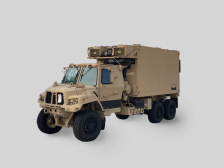Next phase of Army’s TITAN ground station will include 2 variants

The Army’s next-generation ground system to collect and disseminate sensor data will break off into two variants — basic and advanced — once a single vendor is selected early next year.
The Tactical Intelligence Targeting Access Node (TITAN) is considered a critical modernization component for the Army’s multi-domain operations (MDO) concept because it will integrate various types of data from numerous platforms to help commanders make sense of a fast-moving and complex battlefield.
Raytheon Technologies and Palantir were each awarded $36 million last year to compete for the final phase of the contract (in July, Raytheon Technologies, now RTX, had an internal realignment and TITAN now falls under Collins, a RTX business), through rapid prototyping efforts. Both companies concluded various soldier touch points, or test events in which companies put their system through its paces in operational scenarios while users get to offer their feedback on how it works and what tweaks need to be made for the next event.
“In second quarter of ’24, what we anticipate is the selection and award to one of those vendors to move forward into what we’re calling a prototype maturation phase, so PMP, which is the next phase of that rapid prototyping … [at which point] the selected vendor will further mature their prototype through more soldier touch points. And then we intend to have some [of] this capability issued to designated units to allow them to refine the feedback and the [tactics, techniques and procedures] in which it would be employed,” Brig. Gen. Wayne “Ed” Barker, program executive officer for intelligence, electronic warfare and sensors, told reporters during a media call Tuesday.
In that next phase, the Army is planning on having a basic, more expeditionary variant and an advanced variant.
The key difference between the two, Barker explained, is the advanced system will have access to national space assets. As part of the development of TITAN, Northrop Grumman had developed what the Army referred to as a pre-prototype.
Access to that capability will reduce the time cycle to discover data and targets gathered from these sensitive sources. The basic version will have to access that through normal channels, which can take a bit longer as opposed to having a direct link.
“What the Army has to do at this point is we’re going to a lot of different exercises from a network standpoint and understanding where things are going to go at echelon and what that means for our existing modernization efforts,” Barker said. “You can see an instance where capabilities are pushed up, so you might need fewer of an advanced or fewer of a basic.”






